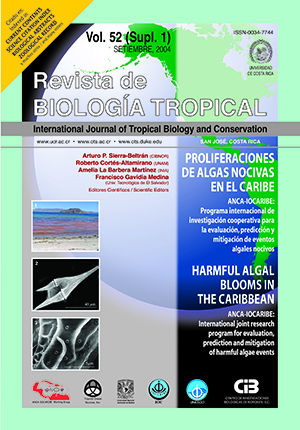Abstract
Some dinoflagellates with benthic habits are related to ciguatera intoxication by fish consumption, especially in tropical areas. In the Mexican Caribbean, ciguatera is relatively common, but only one paper seems to have been published on the subject, and there are very few publicactions on phytoplankton and benthic microalgae. Material collected along the coast of the State of Quintana Roo with phytoplankton net (54 mm) and directly from sediment and epiphytes of macroscopic plants, was searched for toxic and other associated dinoflagellates. Samples were studied by light and scanning electron microscopy. Morphological characters were useful for species identification, but eventually physiological, ecological and molecular characters could also be used. Three species of Gambierdiscus, related to the production of ciguatera toxins, were identified: G. belizeanus, G. toxicus and G. yasumotoi. They are distributed in shallow coastal areas, including coastal lagoons.References
Adachi, R. & Y. Fukuyo. 1979. The thecal structure of the marine toxic dinoflagellate Gambierdiscus toxicus gen. et sp. nov. collected in a ciguatera endemic area. Bull. Jap. Soc. Sci. Fish. 45: 67-71
Almazán Becerril, A. 2000. Estudio taxonómico de algunos dinoflagelados potencialmente tóxicos en el Caribe mexicano. Tesis de Maestría, Fac. Ciencias, Universidad Nacional Autónoma de México, México, D.F.
Balech, E. 1980. On thecal morphology of dinoflagellates with special emphasis on cingular and sulcal plates. An. Centro Cienc. Mar. Limnol., UNAM 7: 57-68
Ballantine, D.L., A.T. Bardales, T.R. Tosteson & H.D. Durst. 1985. Seasonal abundance of Gambierdiscus toxicus and Ostreopsis sp. in coastal waters of southwest Puerto Rico. In Prod. 5th. Int. Coral Reef Congr. Tahiti. 4: 417-22.
Ballantine, D.L., T.R. Tosteson & A.T. Bardales. 1988. Populations dynamic and toxicity of natural populations of benthic dinoflagellates in southwestern Puerto Rico. J. Exp. Mar. Biol. Ecol. 119: 201-212.
Besada, E.G., L.A. Loeblich & A.R. Loeblich III. 1982. Observations on tropical, benthic dinoflagellates, from endemic areas: Coolia, Gambierdiscus and Ostreopsis. Bull. Mar. Sci. 32: 723-35.
Bomber, J.W., D.R. Tindall & D.M. Miller. 1989. Genetic variability in toxin potencies among seventeen clones of Gambierdiscus toxicus (Dinophyceae). J. Phycol. 25: 617-125.
Chinain, M., M.A. Faust & S. Pauillac. 1999. Morphology and molecular analyses of three toxic species of Gambierdiscus (Dinophyceae): G. pacificus, sp. nov., G. australes, sp. nov., and G. polynesiensis, sp. nov. J. Phycol. 35: 1282-1296.
Faust, M.A. 1990. Morphologic details of six benthic species of Prorocentrum (Pyrrophyta) from a mangrove island, Twin Cays, Belize, including two new species. J. Phycol. 26: 548-558.
Faust, M.A. 1991. Morphology of ciguatera-causing Prorocentrum lima (Pyrrophyta) from widely differing sites. J. Phycol. 27: 642-648.
Faust, M.A. 1992. Observations on the morphology and sexual reproduction of Coolia monotis (Dinophyceae). J. Phycol. 28: 94-104.
Faust, M.A. 1993a. Prorocentrum belizeanum, Prorocentrum elegans and Prorocentrum caribbaeum, three new benthic species (Dynophyceae) from mangrove island Twin Cays, Belize. J. Phycol. 29: 100-107.
Faust, M.A. 1993b. Three new benthic species of Prorocentrum (Dinophyceae) from a mangrove island Twin Cays, Belize. J. Phycol. 32: 410-418.
Faust, M.A. 1993c. Surface morphology of the marine dinoflagellate Sinophysis microcephalus (Dinophyceae) from a mangrove island, Twin Cays, Belize. J. Phycol. 29: 355-363.
Faust, M.A. 1994. Three new species of Prorocentrum (Dinophyceae) from Carrie Bow Cay, Belize: P. sabulosum sp. nov., P. sculptile sp. nov., and P. arenarium sp. nov. J. Phycol. 30: 755-763.
Faust, M.A. 1995. Observations of sand-dwelling toxic dinoflagellates (Dinophyceae) from widely differing sites, including two new species. J. Phycol. 31: 996-1003.
Faust, M.A. 1996. Dinoflagellates in a mangrove ecosystem. Twins Cays, Belize. Nova Hedwigia 112: 447-460.
Faust, M.A. & E. Balech. 1993. A further study of marine benthic dinoflagellates from a mangrove island, Twin Cays, Belize, including Plagiodinium belizeanum gen et sp. nov. Phycologia 37: 47-52.
Faust, M.A., S.L. Morton & J.P. Quod. 1996. Further SEM study of marine dinoflagellates: the genus Ostreopsis (Dinophyceae). J. Phycol. 32: 1053-1065.
Faust, M.A. & S.L. Morton. 1995. Morphology and ecology of the marine dinoflagellate Ostreopsis labens sp. nov. (Dinophyceae). J. Phycol. 32: 669-675.
Fensome, R.A., F.J.R. Taylor, G. Norris, W.A.S. Sarjeant, D.I. Wharton & G.L. Williams. 1993. A classification of living and fossil dinoflagellates. Micropaleontology Special Publication 7: 351 p.
Gómez-Aguirre, S. 1998. First record of Pyrodinium bahamense (Dinoflagellata) in brackish waters of the Mexican Caribbean coast. An. Inst. Biol., UNAM, Ser. Zool. 69: 121-123.
Hallegraeff, G.M. 1993. A review of harmful algal blooms and their apparent global increase. Phycologia 32:79-99.
Holmes, M.J. 1998. Gambierdiscus yasumotoi sp. nov. (Dinophyceae), a toxic benthic dinoflagellate from southeastern Asia. J. Phycol. 34:661-668.
John, D.M. & C.A. Maggs. 1997. Species problems in eukaryotic algae: a modern perspective, pp. 83-107. In M.F. Claridge, H.A. Dawah & M.R. Wilson (eds.). Species: The Units of Biodiversity. Chapman & Hall.
Lechuga-Devéze, C.H. & A. Sierra-Beltrán. 1995. Documented case of Ciguatera on the Mexican Pacific coast. Natural Toxins 3: 415-418.
Mann, D.G. 1999. The species concept in diatoms. Phycologia 38: 437-495.
Margalef, R. 1998. Red tides and Ciguatera as successful ways in the evolution and survival of an admirable old Phylum, pp. 3-7. In B. Reguera, J. Blanco, M.L. Fernández & T. Wyatt (eds.). Harmful Algae. Xunta de Galicia & IOC-UNESCO, Vigo.
Nuñez-Vázquez. E.J., A. Almazán-Becerril, A. Heredia- Tapia, D.U. Hernández-Becerril, L. Troccoli-Ghinaglia, B.O. Arredondo-Vega, J.A. Vázquez-Castellanos & J.L. Ochoa. 2000. Incidencia del envenenamiento por Ciguatera en México. In Resúmenes 4a Reunión de Expertos en Envenenamiento por Animales Ponzoñosos; 30 y 31 de marzo, Cuernavaca, México.
Sournia, A. 1986. Atlas du phytoplancton marin. I. Centre National de la Recherche Scientifique, Paris. pp. 216.
Steidinger, K.A. & K. Tangen. 1997. Dinoflagellates. pp. 387-584. In C.R. Tomas (ed.). Identifying Marine Phytoplankton. Academic, San Diego.
Taylor, F.J.R., Y. Fukuyo & J. Larsen. 1995. Taxonomy of harmful dinoflagellates, pp. 283-318. In G.M. Hallegraeff, D.M. Anderson & A.D. Cembella (eds.). Manual on Harmful Marine Microalgae. IOC-UNESCO, Paris.
Yasumoto, T., I. Nakajima, R. Bagnis & R. Adachi. 1977. Finding a dinoflagellate as a likely culprit of Ciguatera. Bull. Jap. Soc. Sci. Fish. 43: 1021-1026.
##plugins.facebook.comentarios##

This work is licensed under a Creative Commons Attribution 4.0 International License.
Copyright (c) 2004 Revista de Biología Tropical


